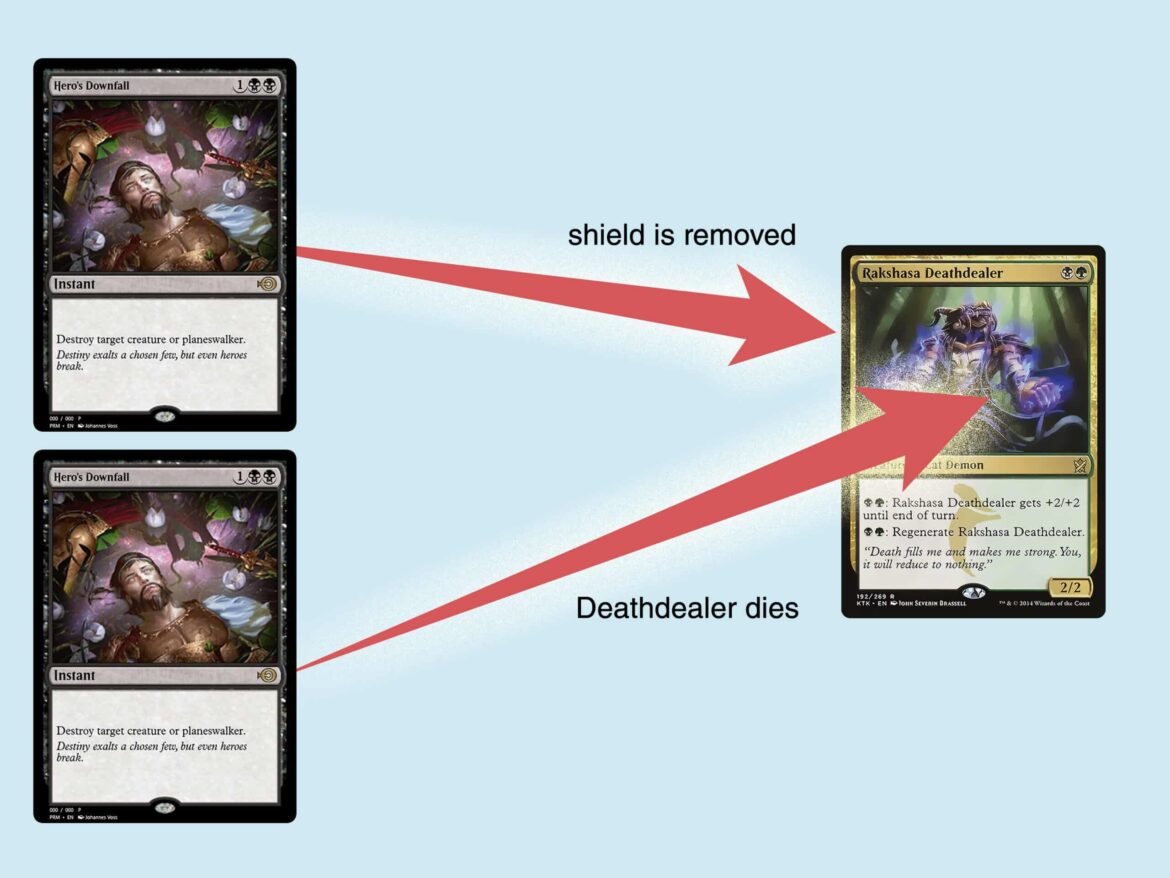802
Regenerate doesn’t just save creatures – it’s a precise tool that rewrites the course of the game. Master the mechanics, shut down your opponents’ turns and form unexpected comebacks.
Magic: The Gathering – Regenerate: How the mechanism works in detail
Magic: The Gathering – Regenerate works like a pact with the devil: you sacrifice resources to delay death – but the price and conditions are strict. This is where you decide whether you actually want to save a creature or waste valuable mana.
- No “healing effect”: Regenerate doesn’t prevent or reduce damage. Instead, it replaces the destruction of the creature with three actions: Tap: The saved creature is tapped immediately, regardless of whether it was already tapped. Remove damage: All damage counters on the creature disappear. Fight Removal: The creature is pulled out of combat to avoid further damage.
- Activation ≠ Guarantee: Even if you pay the cost of Regenerate (e.g. {G} on Cudgel Troll), the creature will only be saved if it would be destroyed this turn. If nothing happens, the shield expires.
- Stacking interactions: Regenerate is put on the stack like an activated ability. Your opponent can respond with Counterspell or Stifle – a risk that many overlook.
- Multiple Use: A creature can only be regenerated once per destruction attempt. If it is threatened again in the same turn, only a second shield will help.
- Hidden Synergies: Cards with tap triggers (e.g. Viridian Longbow) benefit: By tapping during Regenerate, you trigger additional effects.
- Practical example: Your Thrun, Breaker of Silence (4/4, Regenerate for {2G}) blocks an Inferno Titan. Without Regenerate, Thrun dies from the 6/6 damage. You pay {2G} after declaring blockers but before damage is assigned. Result: Thrun becomes tapped, the damage is removed – and survives. However, the Inferno Titan does not hit the player because Thrun leaves combat.
Tactical Depth: Regenerate as a weapon in deck building
Regenerate isn’t a Band-Aid; it’s a strategic signal that reveals whether you’re going for defensive control or aggressive resource lockdown.
- Always save mana for regen abilities, especially in midrange or control decks. An idle Rakshasa Deathdealer with an open {B}{G} forces your opponent to take risky turns.
- Use Mana-Dorks (e.g. Llanowar Elves) to cover regen costs without sacrificing your main mana pool.
- Bluff regen mana, even if you don’t have a card in play. Opponents might stop attacking for fear of losing.
- Show cards with regenerate early in the game to build pressure (e.g. Kheru Bloodsucker in a black-green deck).
- +1/+1 counters: Creatures like Joraga Warcaller don’t just regenerate – they keep all +1/+1 counters, since they aren’t tied to damage.
- Hexproof/Shroud: Pair Regenerate with Hexproof (e.g. Sagu Mauler) to avoid targeted destruction spells.
- Recycle with the graveyard: Use Skullbriar or Mikaeus, the Unhallowed to rebuff creatures later.
- Against Control: In matches against destroy decks (blue-black), Regenerate is worthwhile. Against exile-heavy decks (white, Swords to Plowshares), Indestructible is better.
- Sideboard Tips: Replace Regenerate cards when your opponent uses “can’t be regenerated” effects (e.g. Shadowpriest of Ormend).
- Mistakes pros avoid: Ignore surprise effects: A split-second spell like Sudden Shock bypasses Regenerate because you can no longer react. Protection against state-based actions: Regenerate does not protect against death from 0 life or -X/-X effects (e.g. Toxic Deluge). Wrong timing priority: In multiplayer, you have to communicate exactly when you activate Regenerate – misunderstandings cost games.

